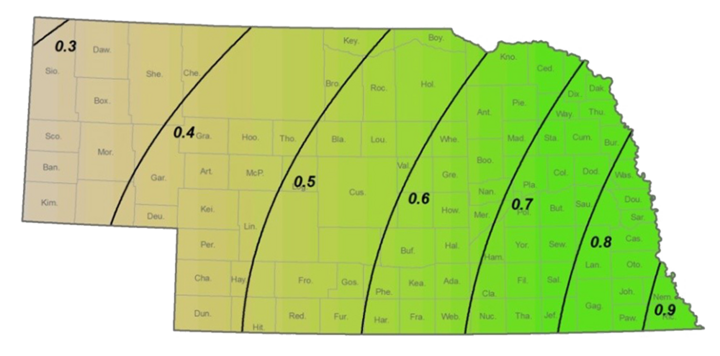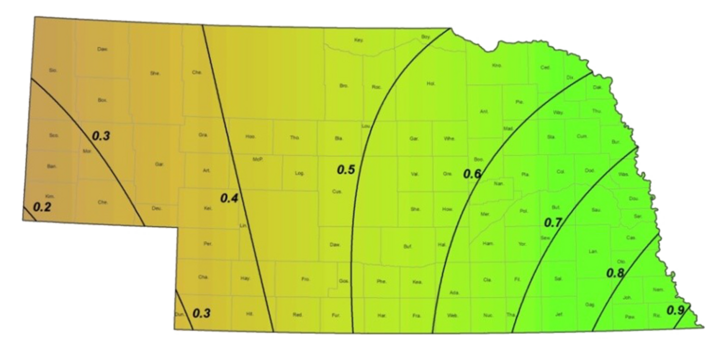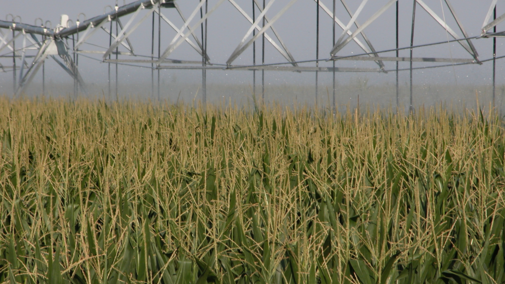The 2017 growing season started with warm dry planting conditions, followed by significant rain delays in May in many parts of the state, and a summer of intermittent weeks of hot and cool temperatures. The net result is that crops may mature over a longer period than usual this fall. Fortunately, the following procedure for making end-of-season irrigation decisions is based on crop maturity stage rather than the calendar.
The last few irrigations of the season require some of the most important water management decisions of the year. An extra irrigation may mean wasting 1 to 3 inches of water and 2 to 5 gallons of diesel fuel per acre. Furrow irrigators may want to decide sooner due to the typical higher application amounts with flood, while pivot irrigators can delay the decision and take advantage of any rainfall that may occur.
Many irrigators apply more water than necessary toward the end of the irrigation season because the crop is using less water per day. The crop is getting more mature and the days are getting shorter and cooler. The average crop water use rate drops from around 2.1 inches per week at silking to only about 1.2 inches per week by the full dent stage. This 40% reduction requires irrigators to adjust their thinking about how much water needs to be applied each week.
Calculating the amount of water needed from rain and irrigation for the crop to reach maturity becomes important after early August. The objective is to leave the field as dry as possible without lowering the yield. This is important for two reasons. First, it’s important to provide room to store free offseason precipitation. In most years even the drier Nebraska Panhandle sees enough precipitation to fill the soil water profile. (On heavier soils it may take only 4 or 5 inches to refill to field capacity; sandy soils would only take 2-3 inches.) The second reason is to help prevent extended harvest delays because of rain. If the field is kept at field capacity, any rain can cause delays and lead to soil compaction from harvest equipment.
Knowing approximately, how much plant available water is remaining in the active root zone is critical for calculating the last few irrigations and will be referred to as the "remaining available water." The best method for determining the amount of remaining soil water is to use a soil water monitoring system. Table II shows the typical amount of water that will be in the different soils types and can be used to help estimate the volume of water. Remember to use the top 4 ft of soil for the active root zone and plan to use the soil water down to 40% of plant available water (60% depletion) after the dough stage for corn/sorghum and the R5 stage for soybeans/dry beans.
Predicting how much rain the field will receive is difficult, but if you do not plan for the possibility of rain, it is easy to apply too much irrigation water. Figures 2 and 3 show the long-term weekly average rainfall for August and September in Nebraska.


Method to Estimate Late-Season Crop Water Needs
To determine how much water from rain and irrigation will be needed to mature the crop, use the method described below and information from Table 1 (below).
Step 1. Based on the current crop growth stage (identified in columns 1 and 2), look up the approximate days to maturity in column 3 and the water use to maturity in column 4.
Step 2. Add the approximate days to maturity to today’s date to estimate the crop maturity date.
Step 3. Subtract the water use to maturity from the remaining available water (as determined by soil water sensors or monitoring). If the number is positive, it indicates adequate soil water to mature the crop; however, if the number is negative it indicates the additional amount of water the crop will need from rain and irrigation to reach maturity.
The following sample calculations illustrate how to use this method.
Part 1
Determine how much water from rain and irrigation will be needed to reach crop maturity assuming the field is located in central Buffalo County, the date is August 10, and the corn crop is at the R4 (dough) stage. For this example the remaining available water is 2.25 inches if the top 4 feet of soil is allowed to dry to 40% of available water-holding capacity.
- Referencing Table 1, corn at the R4 stage should take approximately 34 days to mature and will use about 7.5 inches of additional water to reach maturity.
- Add 34 days to today’s date to get the approximate day of maturity, using Aug. 10 as the example.
Today’s date 8/10 Days to maturity + 34 days Predicted maturity date = 9/13 - Subtract the water required to reach maturity from the remaining available water.
Remaining available water 2.25 inches Water required to mature crop – 7.50 inches Remaining water at maturity – 5.25 inches -
The calculation shows that 5.25 inches of water will be needed from rain and irrigation to mature the crop without limiting yield.
Part 2
Determine the average rainfall per week for the remaining weeks of crop growth and add it into the prediction of how much water may be needed from irrigation. This number should be recalculated each week until the crop is mature.
- Use Figures 2 and 3 to determine the average rainfall per week in August and in September for central Buffalo County.
- The chart shows that, on average, central Buffalo County gets 0.60 inch of rain per week in August and 0.55 inch per week in September. The crop is expected to continue growing for three weeks in August and two weeks in September.
| Remaining available water at maturity | – 5.25 inches |
| Average August rain for three weeks | + 1.80 inches |
| Average September rain for two weeks | + 1.10 inches |
| Water need after accounting for average rain | – 2.35 inches |
The chart predicts that if average rainfall is received over the next five weeks, only 2.35 inches of irrigation would be needed to mature the crop.
Using this information for a center pivot that is set to apply one inch of water per irrigation, the suggested recommendation would be that the system should be off for the next few days to use some of the remaining water. The next inch of water should be applied within the next seven days. Then, the next irrigation should be recalculated using updated soil water readings. The best way to use the remaining water is to delay the start of the last few irrigations a few days each time and react to any rain that might occur during the period. Slowly using the water in the lower portion of the root zone starting in early to mid-August is much better than keeping the profile full until the very end and expecting the crop to use the water all at once.
Differences in Late-Season Irrigation Timing for Corn/Sorghum and Beans
Corn/sorghum and beans are somewhat different in respect to crop water use as they approach maturity. For example, if hot dry windy conditions are experienced in September, daily crop water use will increase. However, since corn/sorghum develop based on heat units, they will use more water per day, but will mature in fewer days using about the average amount of water shown in the chart. Beans develop based on day length. So with the same hot dry windy conditions, they will use more water per day and will still mature at about the same date resulting in more water use than predicted in the charts. Thus, it is very important to monitor soil water in beans until they reach maturity.
For additional details and charts, see NebGuide Predicting the Last Irrigation of the Season.
| Crop Stage | Stage of growth | Approximate days to maturity | Water use to maturity (inches) |
|---|---|---|---|
| Corn R2 | Blister | 45 | 10.5 |
| Corn R4 | Dough | 34 | 7.5 |
| Corn R4.7 | Beginning dent | 24 | 5.0 |
| Corn R5 | 1/4 milk line 1/2 milk line - Full dent 3/4 milk line |
19 13 7 |
3.75 2.25 1.0 |
| Corn R6 | Physiological maturity | 0 | 0.0 |
| Grain Sorghum Stage 6 | Half bloom | 34 | 9.0 |
| Grain Sorghum Stage 7 | Soft dough | 23 | 5.0 |
| Grain Sorghum Stage 8 | Hard dough | 12 | 2.0 |
| Grain Sorghum Stage 9 | Physiological maturity | 0 | 0.0 |
| Soybeans R4 | End of pod elongation | 37 | 9.0 |
| Soybeans R5 | Beginning seed enlargement | 29 | 6.5 |
| Soybeans R6 | End of seed enlargement | 18 | 3.5 |
| Soybeans R6.5 | Leaves begin to yellow | 10 | 1.9 |
| Soybeans R7 | Beginning maturity | 0 | 0.0 |
| Dry Beans R5 | Early seed fill | 35 | 7.0 |
| Dry Beans R6 | Mid-seed fill | 25 | 4.2 |
| Dry Beans R7 | Beginning maturity | 15 | 2.0 |
| Dry Beans R8 | Harvest maturity | 0 | 0 |
| Soil textural classification | Available water in 1 foot of soil at 100% of available water (in/ft) |
Available water in top 4 feet at 100% of available water (in/4 ft) |
Minimum balance in top 4 feet at 40% of available waterA | |
|---|---|---|---|---|
| Fine Sands | 1.0 | 4.0 | 1.6 | |
| Loamy Sand | 1.1 | 4.4 | 1.8 | |
| Sandy Loam | 1.4 | 5.6 | 2.2 | |
| Silty Clay or Clay | 1.6 | 6.4 | 2.6 | |
| Fine Sandy Loam, Silty Clay Loam, or Clay Loam | 1.8 | 7.2 | 2.9 | |
| Sandy Clay Loam | 2.0 | 8.0 | 3.2 | |
| Loam, Very Fine Sandy Loam, or Silt Loam Topsoil | Silty clay loam or silty clay subsoil | 2.0 | 8.0 | 3.2 |
| Medium textured subsoil | 2.5 | 10.0 | 4.0 | |
| aBased on leaving 40% of the available water holding capacity at physiological maturity. | ||||

